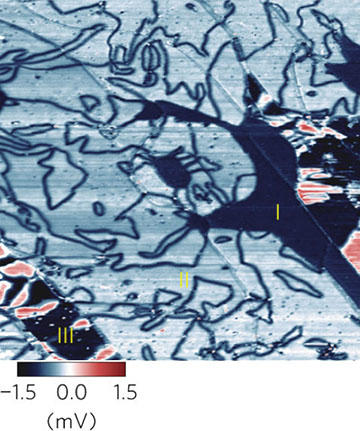
Researchers from the NIST Center for Nanoscale Science and Technology (CNST) and the Republic of Korea's national metrology institute—the Korea Research Institute of Standards and Science (KRISS)—have recently developed a unique nanoscale measurement technique and used it to observe structural disorder in graphene that is fabricated on a silicon carbide substrate.* Graphene, a material made of carbon in a one atom-thick sheet, has promising applications in areas ranging from flexible displays to high speed transistors. However, these applications will require new methods for large area fabrication and for detecting underlying fabrication-related structural defects.
The team's approach relies on local thermopower measurements that use heat transfer from a scanning probe tip to the sample surface, thereby allowing extremely sensitive imaging of nanometer scale disorder in graphene layers. The technique enables the direct observation of nanoscale structural changes in a material by measuring changes in the heat transfer associated with modifications in a material's local electronic properties. Through such local thermopower measurements, the team discovered a boundary between two regions of the graphene layer that have different crystal orientations. The creation of these different regions results from two stacked graphene layers being rotated or translated with respect to each other.
The researchers believe these initial measurements demonstrate a new scanning probe measurement technique that will have significant applications in developing technologies based on graphene and other emerging electrical materials.
The team includes researchers from the CNST, the KRISS, the Korea Advanced Institute of Science and Technology (KAIST), the Korea Research Institute of Chemical Technology, Pohang University of Science and Technology, and Seoul National University.
*Thermoelectric imaging of structural disorder in epitaxial graphene, S. Cho, S. D. Kang, W. Kim, E.-S. Lee, S.-J. Woo, K.-J. Kong, I. Kim, H.-D. Kim, T. Zhang, J. A. Stroscio, Y.-H. Kim, and H.-K. Lyeo, Nature Materials 12, 913-918(2013).
NIST Publication Database Journal Web Site

